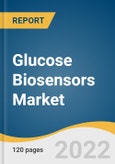The global glucose biosensor market size is expected to reach USD 20.1 billion by 2030. The market is expected to expand at a CAGR of 7.9% from 2022 to 2030. Glucose biosensors are an essential part of glucose monitoring systems that aid in monitoring blood glucose concentration in diabetic patients, which, in turn, helps them to manage and control diabetes and avoid any further complications. The International Diabetes Federation stated that in 2021, 537 million people were diagnosed with diabetes, and the number is anticipated to reach 783 million by 2045.
Emerging innovations in glucose monitoring are expanding the market. Glucose biosensors that use different body fluids such as sweat, blood, saliva, and tear and can be calibrated, are being increasingly researched. For instance, in October 2021, Penn State University researchers invented a novel technique that can assess glucose in sweat rather than blood, thus removing the need for a needle prick.
The market's prominent competitors are taking different initiatives such as funding and acquisitions of medium and small-sized businesses, in order to expand their product portfolio and enhance their manufacturing capacity. For instance, in August 2020, Senseonics Holdings entered into a strategic partnership with PHC Holdings Corporation and Ascensia Diabetes Care. This allowed Ascensia to be the exclusive global distribution partner for Senseonics' CGM systems.
This product will be delivered within 1-3 business days.
Emerging innovations in glucose monitoring are expanding the market. Glucose biosensors that use different body fluids such as sweat, blood, saliva, and tear and can be calibrated, are being increasingly researched. For instance, in October 2021, Penn State University researchers invented a novel technique that can assess glucose in sweat rather than blood, thus removing the need for a needle prick.
The market's prominent competitors are taking different initiatives such as funding and acquisitions of medium and small-sized businesses, in order to expand their product portfolio and enhance their manufacturing capacity. For instance, in August 2020, Senseonics Holdings entered into a strategic partnership with PHC Holdings Corporation and Ascensia Diabetes Care. This allowed Ascensia to be the exclusive global distribution partner for Senseonics' CGM systems.
Glucose Biosensors Market Report Highlights
- by type, the electrochemical biosensor segment accounted for the largest revenue share in 2021 owing to its sensitivity, reproducibility, and ease of maintenance.
- The hospital end-use segment held the largest revenue share in 2021, owing to the extensive use of glucose biosensors in hospital settings and an increase in the number of patients visiting hospitals with diabetes.
- North America accounted for the largest revenue share in 2021. Asia Pacific is anticipated to expand at the fastest CAGR during the forecast period, owing to the improved healthcare facilities and reimbursement policies .
This product will be delivered within 1-3 business days.
Table of Contents
Chapter 1 Methodology and Scope
Chapter 2 Executive Summary
Chapter 3 Glucose Biosensor Market Variables, Trends & Scope
Chapter 4 Glucose Biosensor Market: Type Estimates & Trend Analysis
Chapter 5 Glucose Biosensor Market: End Use Estimates & Trend Analysis
Chapter 6 Glucose Biosensor Market: Regional Estimates & Trend Analysis
Chapter 7 Competitive Landscape
Companies Mentioned
- Abbott Laboratories
- Dexcom
- Ascensia Diabetes Care
- Nova Diabetes Care
- F. Hoffmann-La Roche AG
- Sanofi
- Glysens Incorporated
- Trividia Health
- Bayer
- Lifescan
Methodology

LOADING...
Table Information
| Report Attribute | Details |
|---|---|
| No. of Pages | 120 |
| Published | April 2022 |
| Forecast Period | 2022 - 2030 |
| Estimated Market Value ( USD | $ 10.9 Billion |
| Forecasted Market Value ( USD | $ 20.1 Billion |
| Compound Annual Growth Rate | 7.9% |
| Regions Covered | Global |
| No. of Companies Mentioned | 10 |









